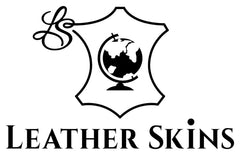What is Leather Tannage?
Leather tannage refers to the process of treating animal hides to transform them into durable and usable leather. This process stabilizes the hide preventing decomposition. There are three most common types of leather tannage: Vegetable Tanned, Chrome Tanned, and Oil Tanned Leather, while combination tanned leather combines one or more of these tannages to produce unique leathers to meet specific needs. Here's a breakdown of the most common leather tannages.
Vegetable Tanned Leather
This is a natural process that uses tannins derived from plant sources, such as, tree bark, wood, leaves, fruits, etc. This method has been practiced for thousands of years and produces leather that is environmentally friendly and biodegradable.
The vegetable tanning method produces leather that is often a warm, earthy color and develops a beautiful patina (darkening) and improves with age! This method avoids using harmful chemicals, making it more sustainable. Vegetable tanned leather is more water-absorbent compared to other types of tanned leather and can stiffen or darken when wet, though it regains flexibility when dry.
Vegetable tanned leather is typically firmer making it a top choice amongst leather crafters looking to carve or emboss leather. Common products made using vegetable tanned leather include wallets, belts, straps, saddles, and tooling.

Chrome Tanned Leather
This is the most modern and widely used method of leather tanning today. Accounting for approximately 80-90%of global leather production due to its efficiency and versatility. Chrome tanning uses a combination of salts, chemicals, and minerals which allows the process to be much faster and efficient.
Chrome tannage allows for higher, brighter colors that are more consistent, and uniform compared to vegetable tanned leather. Often times, chrome tanned leather is softer and more flexible as well. Major advantages to chrome tanned leather over other types of tannages include, fast tanning, economical, produces soft and moisture resistant leather. This methos is commonly used in fashion and accessory leather.

Oil Tanned Leather
This tannage process uses natural oils, waxes, and sometimes fats to produce to produce soft, durable, and sometimes water-resistant leather. Oil tannage enhances the leather's natural properties making it ideal for outdoor and work-related applications.
Typically, oil tanned leather tends to have a "pull-up" look when the leather is stretched or pulled causing the oils or waxes to be displaced creating a lightened distressed (vintage) look. Pull-up leather is highly sought after for its rustic, natural, and aged appearance. Typically used for footwear, bags, wallets, and saddlery.

Combination Tanned Leather
This tannage combines two or more tanning processes, typically vegetable and chrome, to create leather that benefits from the strengths of both methods. This approach allows tanners to produce leather with unique characteristics that are difficult to achieve with a single tanning process.
Understanding leather tannages
Understanding the difference between leather tannages helps you buy leather with confidence. Leather tannages impact the quality and characteristics of the leather, so knowing the differences is crucial for making an informed choice. Explore the different tannages here at Leather Skins to find the perfect leather for your next project.
